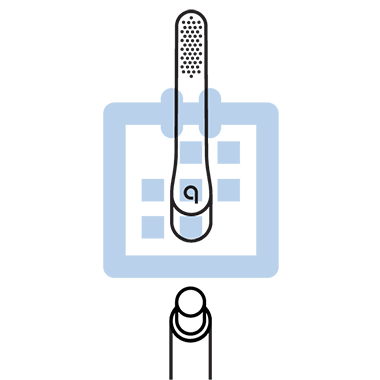Toothbrush Features: Good Vs Gimmick
Share
Shopping for a toothbrush can be a nightmare. How are we supposed to choose between the 5 different types, 10 different modes, and 20 different bristle designs?! Whom should we believe when every brand says its technology is better than the rest (they can’t all be!)?! With a new "feature” added every year, it is only getting harder to select the right brush, so we’ve taken the time to separate what’s good from what’s a gimmick and explain what you should really look for when choosing a toothbrush!
First, some important context
Much of this guide focuses on electric toothbrushes, but as we highlight here, their features can be more beneficial by placebo effect than by actual function! (although there is nothing wrong with that!) The most important thing to know is this: how well you follow good habits when using your brush will in large part determine results! There are simply no shortcuts to these habits, and no features that have the impact that following them has. Unfortunately, most of us aren't following the basics, which is where certain features can lend a helping hand. So we've taken the time to highlight the features we believe make a real impact by guiding good habits (“the good”) and call out those that, while harmless, can bring a far bigger impact to price than to helping you brush better (“the gimmicks”), in the hope of helping you decipher the chaos of the toothbrush aisle! As your dentist will tell you, the best brush for you is the brush that encourages you to brush best, whatever the look, feel, price or function!

Bristles + Head
The good
- Soft, nylon round-tipped bristles
- Refreshed every 3 months
- Single level “flat” design
- Small head
The gimmicks
- Medium / hard / eco bristles
- 3 month warning indicators
- Multi layer / angle design
- "German bristles" (most are!)
The most important thing to look for are soft or ultra-soft, round-tipped bristles. Most people shouldn’t use medium or hard bristles, which can damage teeth Similarly, “natural” or “eco-friendly” bristles are often, sadly, too harsh on teeth and gums. Once you make sure you’re using soft bristles, it’s critical to refresh your brush head every 3 months; worn bristles can potentially be abrasive on your sensitive gums and can’t clean the crevices between teeth and gums effectively (sidebar: while fading colors and flashy lights will remind you to change while brushing, 90% of us forget once we leave the house, so consider a 3 month auto-subscription as the best way to ensure you refresh on time). Next up, Next up, don’t believe the hype about angled bristles ; an even “flat” design will spread the pressure evenly across gums and avoid wearing out the bristles unevenly. When looking at brush sizes, smaller can be better at helping reach all areas of the mouth. Finally, don’t buy into tags like “German engineered bristles” as this usually refers to the same German machines that insert bristles on almost every brush on the market!

Electric Function
The good
- Gentle vibration
- 2-minute timer
- 30 second guide pulses
- Pressure sensor (in theory)
The gimmicks
- “Ultra” / whitening etc. modes
- Rotations / strokes per minute
- Pressure sensor (in reality)
Context is important here, so we recommend reading this to understand in full. In short, a rockstar brusher can maintain great oral health using a simple manual brush without any of the above features, but most of us need a little help to achieve perfect technique; that’s where guiding features, which shape good habits, come in. Vibrations encourage soft brushing, a 2-minute timer ensures you brush for long enough, and 30 second pulses help guide around your mouth evenly. Conversely, rotations, “ultra” vibrations, whitening, and the myriad of other modes available are still debated and studied within the industry (no matter what the ads say!), so we recommend concentrating on brushing better and not on overpaying for extra modes or power unless recommended by your dentist!

Power Source
The good
- Removable regular batteries
- Removable rechargeable batteries
The gimmicks
- Non removable batteries
- Daily charging
- USB charging
There is a misconception that electric toothbrushes with locked-in batteries are different from electric toothbrushes with a replaceable battery. The truth is, most brushes use the exact same AA or AAA rechargeable batteries that you can buy in your local drug store! The only difference is that these batteries are locked inside most electric toothbrushes permanently. Locking away the batteries makes waterproofing easier, but more significantly for your wallet, this inaccessibility often results in you needing to buy an entire new brush when the rechargeable batteries can no longer hold a charge (which easily happens after one – maybe two – years when rechargeable batteries sit on their charging stand for all but four minutes a day). Rather than being locked out of your own brush and being forced to buy new expensive electric brushes, we recommend choosing a brush that lets you access and change your batteries when they eventually can no longer hold a charge. Finally, don’t fall for “USB” charging gimmicks. Most bathrooms don’t have a spare regular outlet, let alone a USB one, and your computer doesn’t live in there either!

Handle / Size
The good
- Comfortable for your hand
- Lightweight. Easy to maneuver
- Simple, symmetrical shape
The gimmicks
- “Ergonomic” designs
- Rubber zones
- Oversized
There is not too much to consider when choosing a handle beyond finding which handle suits you best and encourages you to brush often and with the right grip! More on good brushing grip here, but in short, you should be able to hold it gently like a paintbrush a when gently brushing your teeth and cleaning your gumline. To maneuver a brush properly around the mouth, you will be constantly changing grip position, so a symmetrical shape that has an even grip the whole way around and is easy to rotate and manipulate is best. For example, to clean the backside of your bottom front teeth, you should point the brush upwards while gently brushing up the back of your teeth. Herein lies the problem with self-proclaimed “ergonomic” handles and grip patterns that force you to hold the brush in one particular way! With all that said, personal preference is most important; if you find a handle that feels right to you and makes you excited to brush, then that is the brush for you!

Accessories
The good
- Travel cover
- Wall / shower mount
The gimmicks
- Bulky charging stands
- Bulky "Travel Cases"
If your dentist told you to make sure you stick to just one good habit, it would be brushing twice daily (well, and flossing!). Ideally, this happens in the morning and it is the last thing you do at night (don’t eat or drink after brushing at night!), so a brush that has a wall mount that can be stored easily in the shower or on your mirror (so you never forget!) can make a big difference in easing oral care into your regular routine. If you are rushing out in the morning and often out late in the evening, then choosing a brush that is travel friendly, allowing you to take it to work or wherever you happen to be, is a great way to ensure you never have an excuse to skip a brush!

Sustainability
The good
- Re-usable (when true)
- Recyclable (when true)
- Bio-degradable (when true)
The gimmicks
- Re-usable (when not true)
- Recyclable (when not true)
- Bio-degradable (when not true)
Finally, we want to help you with your research into eco-friendly claims and materials. While of course the future of the industry, there are current limitations that we think you should be aware of, most notably with bristles. Nylon is one of the only bristle material that is gentle enough for teeth and gums; if your brush is not using nylon, then it is potentially too harsh on gums, so be careful! Nylon is unfortunately not biodegradable and cannot be recycled in many states and unless it is removed fully from the brush handle. So if your brush claims to be recyclable and has nylon bristles, then make sure they have a returns program to help you to actually recycle them since you cannot put them in your recycle bin! If they claim to be bio-degradable, then make sure they are not using nylon bristles and, if they are not using nylon, ask your dentist if the material they are using is soft enough for your teeth and gums. Where companies can be more considerate without compromising oral health is in packaging materials. Packaging can be 100% recyclable or bio-degradable and should minimize waste while maintaining a hygienic seal.
Want all the "goods", not the "gimmicks"?
Learn about quip at getquip.com

